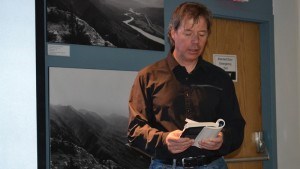
For years after Ken Wylie was buried alive in an avalanche, he blamed anyone and anything else he could.
Wylie was an apprentice ski guide at the time, and on the day of the slide he was assisting fully certified Ruedi Beglinger as they guided a group of skiers up Tumbledown Mountain in the Durrand Glacier area of British Columbia.
That trip ended in tragedy, after thirteen people were swept down the mountain in a massive avalanche. Seven of them died. Wylie was buried for more than half an hour.
Although he wasn’t aware at the time, Wylie was deeply affected by the disaster, and it took him sitting down to write a book about it to realize the extent of his pain.
March 8 Wylie was at the Jasper Yellowhead Museum and Archives, where he gave a presentation to about 50 people on his book. Buried explores the radical realizations he came to about himself and the outdoor adventure industry in the years after the avalanche.
“The obvious reason for the title of the book is that I was buried in an avalanche. The other reason for the title is that I was buried as an individual. I wasn’t living my life authentically, and I think that’s what got me into trouble,” he told the crowd.
He talked a lot about the narrative that nature was to blame for the avalanche, and how destructive that was for him.
“I was looking for something outside myself. And that’s a convenient place to hide for any mountain guide. Because what we do is dangerous. The mountains are dangerous, but one of the things that I think that we miss is gaining knowledge, growth, when we blame the natural world.”
The reality, he said, is that a combination of well-documented weather patterns and terrain features on that particular slope made it a prime candidate for avalanches. At the time Wylie knew that, but his own social insecurity kept him from speaking up.
In his book Wylie explores seven events from his past that he said all fed into his inaction on that day. They all shared a common theme of putting himself in physical danger because he was too insecure or too compelled be be liked.
“It’s really fascinating to me that I was able to ... put myself in these positions where I was taking really big physical risks, and yet unable to take the social risk and say ‘no I’m not up for that,’” he said.
Wylie spent a lot of time considering vulnerability, and said he believes that one of the reasons extreme adventurers feel such a connection to the places they’ve “conquered” is because they were in some way vulnerable.
“That’s exactly why people like us love the outdoors, because we allow ourselves to go into places and be vulnerable in the terrain; it’s that vulnerability that connects us to a place,” he said, suggesting that for some, being physically vulnerable while clinging to the face of a cliff, or skiing down a mountain at a 33 degree angle, is a substitute for emotional vulnerability.
He harkened back to the day of the avalanche, when they were breaking right before they started to climb the mountain.
“All I needed was to say to my guests, ‘I don’t think this is the right thing to do,'" he said.
But he didn’t, and he paid dearly for that decision. It’s only now, after more than a decade of reflection, that he has come to realize it.
Trevor Nichols
[email protected]
